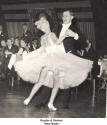From Mazurka in 1750
to Hip Hop
in 2008 (2 of 4)
by Horst Kessler
 The ups and downs of public dancing over 250 yearsBallroom Dancing is a wonderful, gracious recreational activity and exercise and has been so for centuries. Who started it where and when? I asked Ballroom Dance Enthusiast and Teacher – Horst Kessler – for a brief relaxed summary of the history of Ball Room Dance, the kind that you and I can learn, not the "Dancing with the Stars" kind. He happily obliged and produced a series of four segments with anecdotes pertaining to the particular styles and times interspersed with his own experience. This is the second segment in the series of four. If you missed the first, you can find it at this website address: www.echoworld.com/B08/B0803/B0803HW2.htm ...Herwig Wandschneider 1920 – 1940sWhat up to then was reserved for the
Noblesse, changed now decisively. Dancing in all its forms
became part of daily life, which routinely included a Saturday
evening dance. Mr. Fox started the Social Foxtrot in New York
City in 1920. The
While the soft romantic Bolero arrived from the Dominican Republic (the more dynamic Bolero was danced in Cuba, Mexico, and Spain), the Black Bottom and Shimmy - the wildest dances so far - turned New York City completely around, and Parisians went crazy with the Charleston, adopted from its beginnings in the African-American communities of Charleston, South Carolina. Jazz and the Lindy Hop crossed the Atlantic from New York. Here in Canada, Guy Lombardo and his band (from London, Ontario) arrived on the dance scene and filled the dance halls first in Canada and later in the USA..
It was a very special era, seemingly out of step with the problems of the Great Depression. But for the millions of dancers around the world, it was all a natural drive with an abundance of enthusiasm and plenty of energy devoted to the dance floor. Horst Kessler |





